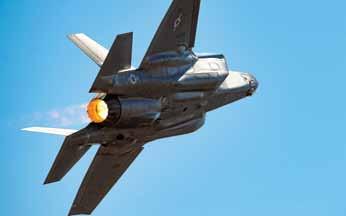
3 minute read
Major Milestones in 2022: Military aviation
From hypersonic strike missiles to sixth generation combat aircraft, as some major projects fructified, the year 2022 saw military aviation technology progressing in leaps and bounds
By Air Vice MArshAl sAnjAy BhAtnAgAr (retd)
the year has been significantly eventful, we look at some major milestones achieved in the military aviation domain.
German air Force decides on F-35s Lockheed Martin’s F-35 undoubtedly seems to be the fighter aircraft of the year 2022. Germany in March 2022 put to rest its long raging debate about the best aircraft to replace its ageing Tornado strike fighters. F/A-18E/Fs and EA-18Gs so far was a strong contender, the German government decided to buy 35 Lockheed Martin F-35, at an estimated cost of Euro 7.6 billion, and additional Euro 2.4 billion for weapons and infrastructureat its operating base.
In 2021, Finland and Switzerland selected the F-35, thereafter, the Czech Republic opted for F-35As and Greece submitted a request to purchase the US built fighter.
The F-35 is a $412 billion programme, started in 2019, and is yet to enter full rate production, owing to testing delays and other issues. The US Air Force (USAF) plans to buy 1,763 of these, although it has hinted it may cut that to 1,050; the US Navy wants 273; and the US Marines want 420. Under current plans, the Pentagon will buy one third of its 2,470 aircraft F-35 fleet (including 14 test models) before green lighting full rate production. 2022 was also the year when, delivery of new F-35s was temporarily halted when it was discovered that there were Chinese made materials in the aircraft.
automated reFuelinG
In July 2022, Airbus’ A330 Multi-Role Tanker Transport (MRTT) became the first tanker to be certified for automatic air-to-air refueling (A3R) without a boom operator. Spain’s National Institute of Aerospace Technology signed off on the A3R capability to refuel the F-16 during daylight following a test campaign in collaboration with the Republic of Singapore Air Force.

A3R as a technology is developed and patented by MTSI that makes the receiving aircraft passive. This capability has been developed with an objective to improve overall safety of aerial refueling missions by accurately maneuvering the hose to the receiving aircraft through the use of machine vision and autonomous controls. A3R allows manned or unmanned tanker to refuel autonomous systems in a manner that keeps them focused on the mission at hand. This solution can easily be configured to various host platforms and provides a means to make legacy and future UAS systems air refuellable.
KF-21 Flies
After being unveiled in April 2021 during a rollout ceremony at the headquarters of Korea Aerospace Industry (KAI) at Sacheon Airport, the KAI KF-21 Boramae fighter completed its first flight on July 19, 2022.

The KF-21 Boramae (young hawk’ or ‘fighting hawk’) is a Korean lead fighter aircraft development programme with the goal of producing an advanced multirole fighter for the South Korean and Indonesian Air Force. It is powered by a pair of General Electric F414s engines, the aircraft carries four captive MBDA Meteor missiles. Programme partner Indonesia later reiterated its support for development of the KF-21.
Manufacturing is scheduled to begin in 2026. At least 40 aircraft are planned to be delivered by 2028, with South Korea expecting to deploy a total of 120 of the aircraft by 2032. It will also be available for export market, as of now, Poland has shown interest in joining the programme.
B-21 raider
Northrop Grumman’s B-21 Raider was unveiled on December 2, 2022 at the company’s site in Palmdale, California, marking the first time the world’s first sixth-generation aircraft to be seen by the public. The Company unveiled B-21, 34 years after the unveiling of its predecessor B-2 and seven years after the company won the Long-Range Standoff Bomber contract. The USAF plans to buy 100 B-21s to replace its B-1s and B-2s, beginning in the mid-2020s.
Hypersonic VeHicles
Several countries are developing hypersonic weapons, which fly at speeds of at least Mach 5. There are two primary categories of hypersonic weapons:
• Hypersonic glide vehicles (HGV) are launched from a rocket before gliding to a target.
• Hypersonic cruise missiles are powered by high-speed, airbreathing engines, (scramjets) after acquiring their target.

Unlike ballistic missiles, hypersonic weapons do not follow a ballistic trajectory and can maneuver enroute to their destination. Hypersonic weapons could challenge detection and defend due to their speed, maneuverability and low altitude of flight.
The US has actively pursued the development of hypersonic weapons as a part of its conventional prompt global strike programme since the early 2000s.
The US Government has shown a growing interest in pursuing the development and nearterm deployment of hypersonic systems. This is due to the fact that both Russia and China, have made numerous technological advances, both countries have a






